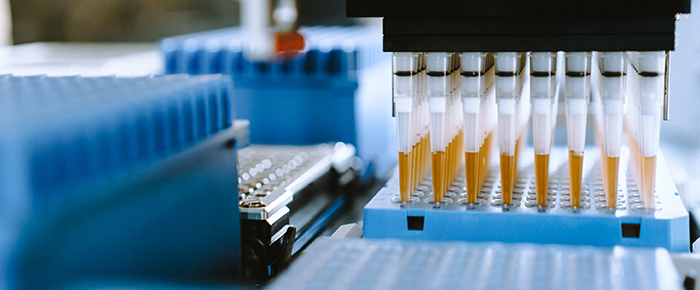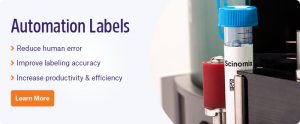 With ever-increasing demand, biobanks are turning to automation to help maintain sample integrity and to uphold their demanding standards of specimen tracking. Automation can be implemented to varying degrees at various stages of the biobanking process to improve access, cost, and throughput.
With ever-increasing demand, biobanks are turning to automation to help maintain sample integrity and to uphold their demanding standards of specimen tracking. Automation can be implemented to varying degrees at various stages of the biobanking process to improve access, cost, and throughput.
Manual sample collection
The collection, processing, storage, and retrieval of samples by biobanks and biorepositories should be standardized, harmonized, and quality controlled to the highest possible level to ensure consistent quality1. This can be achieved by implementing a quality management system (QMS) and the adoption of standard operating procedures (SOPs). Implementing technical solutions can support this process, particularly the automation of critical process areas in biobanking. By reducing or eliminating human handling steps, automation improves reproducibility and accuracy and decreases the incidence of mislabeling or misplaced samples.
While automation can be implemented at almost every step of the biobanking process, improving sample quality, and reducing errors, the one step that still needs to be handled manually is the collection itself. This process requires a trained professional to collect the sample themselves, though the process can still be standardized using SOPs. This can include minimizing the time between sample collection and freezing, which can affect the specimen’s quality.
Automated vs manual tracking & transport
Automating the transport of biological samples to the biobank from clinics and pre-analytical labs can provide several benefits over manual sample transport. The primary advantage is the ability to deliver specimens 24/7, without the need for staff to be present at all times, reducing high personnel costs. Moving samples within the lab can also be augmented with automated workstations. For example, samples can be moves automatically to an aliquoting module, where the required aliquots are processed and then transferred to storage for preservation.
The first thing biobanks must do when they receive new samples is to log them into their tracking system. This can prove to be a time-consuming and tedious process, prone to input errors if done manually. However, the process can be automated with the use of barcodes. The samples are scanned upon entry, and all relevant information is entered into the laboratory information management system (LIMS) for biobanks. The use of automated barcode scanning at every step of the process is the best way to ensure accurate tracking. Once scanned, the reader relays the information to the LIMS, and the sample is processed according to predefined work orders. Pairing barcode labels with a LIMS is a must for any biobank that manages a variety of samples, as it can also integrate with electronic medical and health records for improved specimen tracking.
Automated sample processing
A number of systems have been developed to automate sample processing steps in the biobanking workflow. This includes automated systems that handle simple tasks, such as liquid handling and aliquoting, to more complex jobs, including performing DNA extraction. In fact, there are a variety of systems that support different extraction methods available, using magnetic beads or centrifuged based precipitation methods1. Moreover, nearly all pre-analytical processing of liquid samples can be automated. However, much still needs to be done manually when processing tissue samples, such as tissue sampling and partitioning.
Special attention needs to be paid to the tube format used when processing samples using automated systems. If samples are to be aliquoted, the robots will need to be able to pick and place the tubes as well as open and close them. The identification of the tubes should also be taken into consideration. While cryo vials can be labeled during the process using print-and-apply systems or supplied pre-barcoded, cryo straws should be labeled prior to filling. The straws are then hermetically sealed at both ends, making further individual automated handling of these sample vials untenable.
Automated cryogenic storage system
The freezing of samples is key to ensuring specimen integrity and subsequent performance of any applied analytical methods. If samples are to be frozen, this should occur immediately after sample aliquoting. This process can be standardized by using -20°C pre-cooled 2D barcoded or labeled tubes that can then be transferred to freezer storage immediately after aliquoting. When handling cells, however, a controlled freezing rate of -1°C/min is essential. Automated systems can achieve this by directly monitoring the temperature of samples and using dry ice to transfer them to their final storage container. This has been shown to provide greater cell-viability compared to traditional isopropyl alcohol cryo containers.
Automated storage systems also show a uniform temperature throughout with minimal deviations to the set temperature. This isn’t the case for non-automated freezers, where the coldest area is in the back middle, with substantial temperature fluctuations due to sample handling when opening the freezer1. There are currently several automated biobank systems that can store samples at -80°C or in the vapor phase of liquid nitrogen. However, the major robotic components are located in areas far above the actual storage zone at temperatures between 0°C and -20°C. This ensures the mechanical components remain in optimal working order for longer and minimizes the thermal transfer from the parts to the samples. Whether final storage is done at -80°C or in liquid nitrogen, a liquid nitrogen backup is highly suggested. This ensures cooling is not interrupted under any circumstances. The number of samples to be stored and the duration should also be considered, as -80°C systems can often store more samples. At the same time, liquid nitrogen storage is recommended when storing samples for extended periods.
Sample retrieval
The sample retrieval biobanking process can also be automated to provide the requested samples to researchers quickly. Biobanks can pick individual samples from their inventory or even supply only parts of the required biological samples. The automated freezers can also be used to thaw the required samples if necessary. Accurate identification is critical for precise sample retrieval. In cases where only an aliquot of the specimen is required, the receiving vial needs to be labeled with the correct associated information. This will also allow for complete tracking of the specimen while also generating a record of how much of the original sample remains. When handling samples stored in straws, as there is currently no system on the market that allows automated opening and sample recovery from these containers, cryo straws must be processed manually.
LabTAG by GA International is a leading manufacturer of high-performance specialty labels and a supplier of identification solutions used in research and medical labs as well as healthcare institutions.
References:
- Baber R, Kiehntopf M. Automation in biobanking from a laboratory medicine perspective. J Lab Med 2019; 43(6): 329–338.




